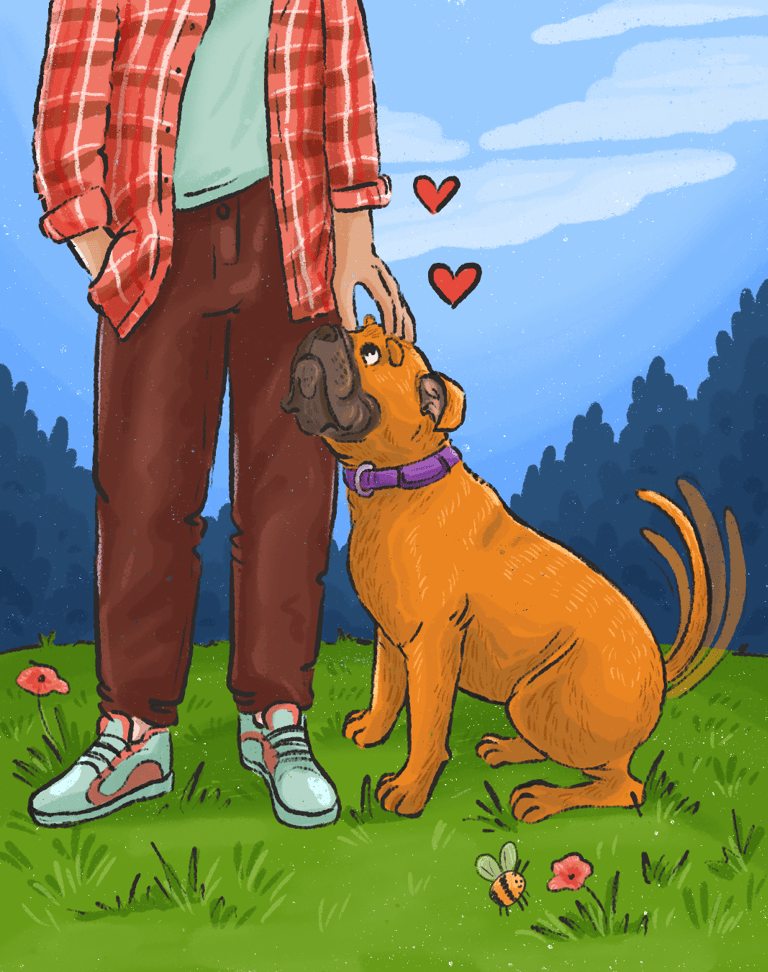We do not subscribe to any form of alpha dog thinking. This is an outdated concept based on study of wolves later disproved by its own author we have linked a video by the pop culture detective that explains it better than we could.
That being said, with any form of training there needs to be an element of you leading as you are the one imparting on them how you want them to behave. Think more leading the dance than leading an army. We will also use the term 'pack' in this guide, we just like it as the collective term for dogs.
While there isn't a step by step on how to be a leader to your dog there are some things you can do to nurture this role. The goal here is not to dominate but to shape in their mind that you are to be trusted to steer them in the right direction.
Some of the exercises in this guide will naturally create a leader role for you, such as loose-lead training and impulse control. Starting out it can be as simple as getting your dog to sit before doing anything. It is important to note we never deny the thing they want, we just delay it until they ‘check in’. This is something we will add to more in the section ‘Impulse control’.
Eventually you can add duration to how long they are sat, adding a slightly longer gap in between sitting and getting the reward. Hand feeding in general will help a great deal as they know that their favourite thing (at least in Conker’s case) is coming from you.
With everything, consistency is key. If one day you are being clear with them but the next letting them run around to do as they please, they will learn it's always worth checking who's in charge on what day. Ultimately we will be taking away a huge amount of stress from them as they will know that in any situation they can look to you for guidance rather than having to work things out themselves.
Leadership



Corrections
Corrections aren't fun and they aren't a bit we enjoy (or even enjoy writing about) but they are necessary. We have found corrections to be needed to help your dog understand what isn't acceptable behaviour. We as partners to our dogs need to make sure that the correction is always appropriate and applied with care. It is not a punishment- it is simply a “No” that the dog can understand. A correction should never be the end of the story. Once we have shown them what not to do, we then have to show them what behaviour we want instead, and reward them to reinforce it.
We can't stress enough how striking a dog or making them fearful does not work for training. No good relationship has ever been based on fear, they are built on a foundation of trust and boundaries. If a dog fears you or the tools you are using, you will only reinforce negative feelings.
Below is some guidance for an appropriate escalation of corrections. We always start with the most gentle, yet still appropriate correction possible and then only move up if the dog continues to make the wrong choice. Each situation requires discretion.
What do we mean by appropriate? If your dog is being unsafe and all you are doing is saying AH AH then that isn't appropriate- you need to take charge of the situation while still showing compassion. On the other hand, if your dog is making a very minor mistake and you meet them with a strong collar hold and a very long time out, then you are using too strong of a correction for the situation.
Another part of assessing the appropriateness of a correction is the dog themselves- their temperament, history with poorly used corrections, physical size/strength and body condition/wellness should all play a part in your decision making process. If you are triggering an old fear response with one of the below suggestions, then it is not one you should use for the time being.
Correction Examples
Vocal corrections
Start with a sharp AH AH
Then go to a strong and firm NO while changing your body language from relaxed to stern to indicate that this isn't play.
This can be used with the other steps and on its own.
House line redirect
A house line is a lead without a loop, clipped to their collar and kept on while around the house.
When you are starting out with training we recommend having a house line on any time they aren't in their crate or settled on a bed.
When they make a wrong choice, take the lead and move them away from what they are doing towards a positive choice which you can reward.
Time out
Put them in sit and make them wait 10 seconds, then release (‘Go on then’ and a hand wave) This is all that will be needed eventually.
Going into sit isn't the correction here, it's stopping whatever they were doing and having to be still and engaged with you.
Out of control time out
Safely take control of their collar and put them in sit. Please see the note at the end of the chapter about using their collar in this way.
If you are challenged, affirm your hold on the collar with both hands while being very careful not to choke or hurt them (or yourself).
Keep them there until they have settled while also using your strong and firm No, maintaining confident body language.
If a longer time-out is needed:
When you aren't cool and calm and need your own time-out, or if your dog is being a wild gremlin demon and nothing else is working, then put them in their crate for a few minutes for a reset until you are both ready to try again.
Only let them out when they are calm and quiet again, so that you aren’t rewarding bad crate behaviour.
Take this time to set up for success next time around!
If they couldnt listen to you it's because they had an unmet need that was extremely strong. We must address that before we can expect engagement from them.
These will be used throughout our training and also throughout your day. Correct unwanted behaviour, redirect to a wanted behaviour and then reward the positive. By doing so you are creating value in a behaviour and making them more likely to do it in future.
Along with the markers in the next chapter, this will make up a huge chunk of the overall training at the start and then over time will need to be used less as your dog learns what is and isn’t acceptable. Correction is just the other side of the coin.
Make sure your corrections are appropriate in scale to the situation and the dog. If you under react, you show them that they don't have to listen and they may escalate. If you over react they may start to fear you. The instinct for this comes with practice.
Dog is doing a negative behaviour
Appropriate correction
Direct to a correct behaviour e.g. to chew a bone or to sit on a bed
Mark the behaviour with your marker word Yes! immediately. (This is the pre-reward which we will go over next)
Reward
ANY correction that relies on you holding the collar needs to be built on a foundation whereby holding their collar is a positive but not exciting situation. This foundation is built with the following very simple exercise-
Make sure you and your dog have neutral energy
In the same moment, take their collar with one hand, say “Yes” and give them one piece of their normal kibble.
Continue to reward while holding their collar
When you let go, the treats stop
Repeat several times a day




